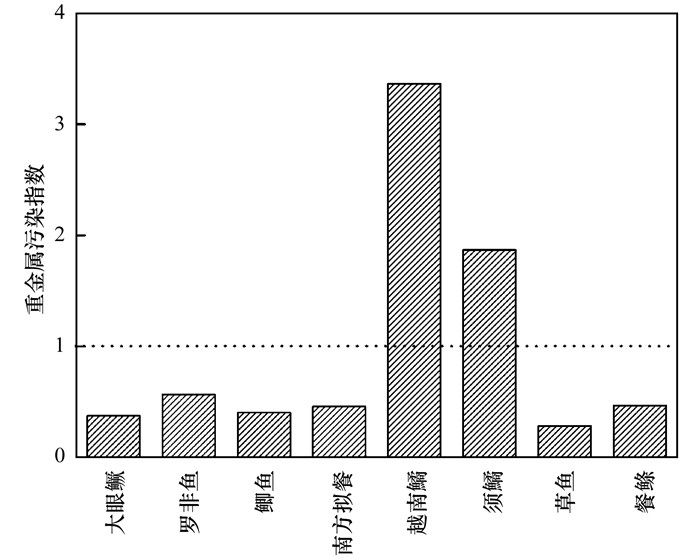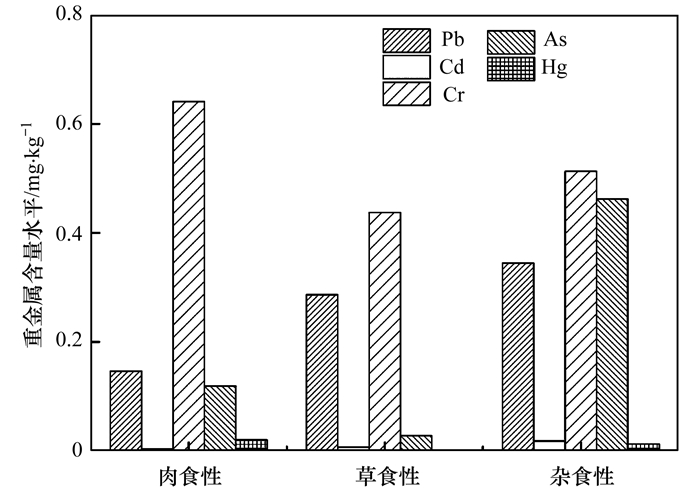2. 环境保护部华南环境科学研究所, 广州 510530;
3. 锦州医科大学公共卫生学院, 锦州 121000;
4. 中国科学院大学, 北京 100049;
5. 国家环境保护环境污染健康风险评价重点实验室, 广州 510530
2. South China Institute of Environmental Sciences, Ministry of Environmental Protection, Guangzhou 510530, China;
3. School of Public Health, Jinzhou Medical University, Jinzhou 121000, China;
4. University of Chinese Academy of Sciences, Beijing 100049, China;
5. State Environmental Protection Key Laboratory of Environmental Pollution Health Risk Assessment, Guangzhou 510530, China
重金属污染对生物地球化学循环的可持续性和生态风险影响问题日益受到全球关注[1, 2].重金属因其高毒性、持久性及生物富集与放大性而具有特殊的生态毒理效应[3].鱼类富含对人体健康有益的高蛋白、低饱和脂肪酸和奥米伽脂肪酸, 是人体蛋白质补充的重要来源[4, 5].然而, 鱼类可能受到多种来源的重金属污染, 包括工业废水、市政污水及其河川径流[6~8].鱼类能从水体和沉积物中积累富集重金属[9, 10].鱼体内重金属长期积累会对生物圈的生物地球化学循环产生影响.重金属沿着食物链的生物放大作用导致生态系统破坏与人体健康风险[2, 3, 11, 12], 尤其是摄入的重金属污染的鱼类超过允许每日推荐摄入量时, 存在显著的人体健康风险[12, 13].因此, 有必要开展食物链最顶层消费者的人类食用鱼类的重金属健康风险评价[14].
关于不同水域中鱼类重金属的研究资料较多, 且多数研究都集中在鱼类肌肉组织.例如徐青[15]研究发现, 湘江Cd污染较为严重, 与广东北江[16]和大亚湾地区[17]及山东地区[18]水平相当, 高于珠江[19]鱼类的污染水平, 也相对高于美国、澳大利亚以及西班牙[20~22]等国的检测结果. Leung等[2]研究了珠江三角洲地区鱼类重金属的污染情况, 罗非鱼体内Pb的含量水平明显高于所测的其他鱼类.
刁江位于广西西北部, 流域面积3 585 km2, 干流长229 km, 为红水河最大的一级支流.刁江流域的锡、铅、锌、锑等重要矿产资源丰富、储量大、分布集中, 是我国重要的有色金属工业基地之一[23]. 20世纪80年代以来, 广西刁江上游有色金属矿山开发活动产生的采矿废水和尾矿渣的排放已对刁江水体和周边的土壤造成了严重污染[24~30].但是目前对于刁江野生鱼类重金属累积特征及其健康风险的研究鲜有报道.为此, 本文将以广西刁江水系野生鱼类为研究对象, 分析野生鱼类体内5种重金属(Pb、Cd、Cr、As、Hg)的含量水平, 探讨重金属在不同野生鱼类体内的积累特征, 评估当地居民通过摄食鱼类的重金属健康风险, 以期为广西刁江水系重金属污染防治、生态环境保护提供基础数据及科学依据.
1 材料与方法 1.1 样品采集2013年11月, 在广西河池金城江区沿着刁江水系采集8种鱼类, 79个样品.鱼类种类包括大眼鳜、罗非鱼、鲫鱼、南方拟餐、越南鱊、须鱊、草鱼、餐鲦.样品采集后立即冷藏运回实验室, 测定鱼类体长、体重等形态学参数, 如表 1所示.解剖后取肌肉组织并于-20℃保存备用.
|
|
表 1 广西刁江水系野生鱼类样品信息 Table 1 Information on wild fish species from Diaojiang River, Guangxi |
1.2 重金属含量测定
准确称取鱼类肌肉样品1.000 0 g到聚四氟乙烯试管中, 加入20 mL硝酸加盖过夜后, 将聚四氟乙烯试管放入石墨消解炉(PE50-48) 中, 逐步升温至120℃, 加热120 min, 取出聚四氟乙烯试管充分冷却后加入3~5 mL高氯酸直至样品完全溶解, 然后加入5 mL硝酸继续加热至溶液剩余1~2 mL, 转移至25 mL比色管中, 定容后摇匀, 用一次性针筒抽取10~12 mL溶液通过聚醚砜过滤至15 mL塑料离心管中, 上机测定重金属含量水平.本实验消解所用试剂均为优级纯, 水为超纯水, 所用器皿均用15%硝酸浸泡过夜, 超纯水冲洗3~5次, 晾干备用.
镉、铬和铅采用原子吸收分光光度计(岛津AA800) 进行分析, 砷和汞采用原子荧光光度计(北京普析通用仪器有限责任公司, PF6-2型)进行分析.利用加标回收方法进行质量控制.每隔10个样品添加2个有证标准物质(GBW-10020) 进行质量控制, 同时按照10%的原则进行平行样品测试.各元素的加标回收率范围为88.73%~108.41%, 符合重金属分析质量控制的相关要求.
1.3 鱼类重金属污染评价 1.3.1 评价标准鱼体内重金属污染程度评价标准按照国家食品安全标准《食品中污染物限量》(GB 2762-2012) 执行[31].
1.3.2 评价方法本研究利用均值型污染指数法评价不同野生鱼类的重金属污染状况.计算公式如下:

|
式中, PI为鱼体内重金属污染指数; n为重金属污染物的种类数; Ci为鱼体内重金属实测值平均含量; Si为某种重金属污染物的评价标准; PI值越大, 说明鱼类受污染程度越严重[32].根据鱼类体内重金属含量水平, 按照表 2的分级标准进行评价.
|
|
表 2 鱼类重金属污染指数分级 Table 2 Index classification of heavy metal pollution in fish species |
1.4 重金属健康风险评价
本研究利用目标危害系数法(THQ)评估重金属暴露的健康风险[33]. THQ是美国环保署(USEPA)提出的一种用于评估人体通过食物摄取重金属风险的方法.该方法假定人体摄入剂量等于吸收剂量, 以测定的摄入量与参考剂量的比值作为评价标准, 具体计算公式如下:
单一重金属风险计算公式:

|
多种重金属复合风险计算公式:

|
式中, EF为接触频率(d·a-1); ED为平均寿命(70 a); FIR为消化食物的比率[g·(人·d)-1]; c为食物中重金属的含量水平(mg·kg-1); RFD为参比剂量[mg·(kg·人)-1]; WAB为人体平均体重(kg); TA为平均接触时间(ED×365 d·a-1).
当THQ比值小于1时, 暴露人群无明显健康风险; 当THQ比值大于1时, 暴露人群存在健康风险.由于多种重金属可以共同作用对人体健康产生危害, 重金属的总危害系数(TTHQ)等于各种重金属的危害系数之和.
根据USEPA的数据资料, Pb、Cd、Cr、As和Hg的RfD分别为0.004 mg·kg-1、0.001 mg·kg-1、1.5 mg·kg-1、300 mg·kg-1和0.000 1 mg·kg-1.基于广西居民膳食营养状况调查资料, 平均每人每天摄入水产品24 g, 标准体重以55.9 kg计算.
1.5 数据处理与分析鱼类重金属含量水平采用Excel 2007进行整理; 实验结果采用SPSS 17.0软件进行统计分析(P < 0.05);图形采用Orign 8.0软件制作.
2 结果与讨论 2.1 鱼类重金属含量水平在所有鱼类样品中, Pb、Cr和As均能检出; Cd和Hg的检出率分别为88.61%和79.75%.不同鱼类体内重金属含量水平差异较大(P < 0.05), 如表 3所示, 在所有鱼类样品中, Pb、Cd、Cr、As和Hg的含量范围分别为0.041~1.160 mg·kg-1(平均值为0.317mg·kg-1)、0.000 1~0.066 mg·kg-1(平均值为0.018 mg·kg-1)、0.173~0.789 mg·kg-1(平均值为0.522 mg·kg-1)、0.010~2.420 mg·kg-1(平均值为0.397 mg·kg-1)、和0.000 7~0.077 mg·kg-1 (平均值为0.016 mg·kg-1).对于Pb而言, 须鱊、南方拟餐和餐鲦中Pb的含量水平较高, 分别为1.026、0.452和0.439 mg·kg-1.对于Cd而言, 须鱊、越南鱊和南方拟餐中Cd的含量水平较高, 分别为0.053、0.026和0.025 mg·kg-1.对于Cr而言, 大眼鳜、罗非鱼、鲫鱼和越南鱊的含量水平较高, 分别为0.641、0.571、0.581和0.559 mg·kg-1.对于As而言, 越南鱊和须鱊中As的含量水平较高, 分别为1.574 mg·kg-1和0.661 mg·kg-1.对于Hg而言, 南方拟餐和餐鲦中Hg的含量较高, 分别为0.034 mg·kg-1和0.028 mg·kg-1.广西刁江水系鱼类体内Pb、Cd、Cr、As和Hg的平均含量水平均低于珠江及松花江水系鱼类的含量水平[34, 35]; Cd和Cr的含量与安徽蚌埠食用鱼类的含量处于同一水平, Pb和As的含量却高于安徽蚌埠食用鱼类的含量, 而Hg的含量低于该区域鱼类含量[36].此外, 本研究区鱼类重金属含量水平明显低于孟加拉邦仕河鱼类样品中的重金属含量[37], 这可能与孟加拉邦仕河接纳未经处理工业废水有关.
|
|
表 3 广西刁江水系野生鱼类样品重金属含量水平1)/mg·kg-1 Table 3 Concentrations of heavy metals in wild fish species from Diaojiang River, Guangxi/mg·kg-1 |
2.2 鱼类重金属污染评价
利用食品安全国家标准《食品中污染物限量》(GB 2762-2012) 标准对不同种类鱼体重金属含量进行了评价, 结果表明:在所有鱼类样品中, Pb和As的含量水平出现超标现象, 超标率分别为5.06%和64.56%.在所有鱼类样品中5种重金属平均含量水平从高到低为Cr>As>Pb>Cd>Hg.须鱊Pb的平均含量水平超标, 最大超标倍数为1.16倍; 大眼鳜、罗非鱼、鲫鱼、餐鲦、南方拟餐、越南鱊、须鱊中As的含量水平超出标准; 而Cd、Cr和Hg均未出现超标现象.
广西刁江水系野生鱼类重金属污染指数如图 1所示. 8种野生鱼类中重金属的污染指数具有种属差异.越南鱊和须鱊的重金属污染指数均大于1, 说明这2种鱼类受到重金属严重污染; 罗非鱼重金属污染指数大于0.5, 小于0.7, 处于中污染水平.其他鱼类重金属污染指数大小顺序依次为餐鲦>南方拟餐>鲫鱼>大眼鳜>草鱼, 均大于0.2, 处于轻污染水平.

|
图 1 广西刁江水系野生鱼类重金属污染指数 Fig. 1 Pollution index of heavy metals in wild fish species from Diaojiang River, Guangxi |
生物体内某种重金属含量水平除以水体中某种重金属的含量水平即得到生物体对该种重金属的富集系数.刁江不同监测断面水体中Pb、Cd、Cr、As和Hg的平均含量水平分别为0.29、0.43、0.41、29.90和0.02 μg·L-1.根据鱼体和水体中不同重金属含量水平计算富集系数, 如表 4所示, 在所有鱼类样品中Pb、Cd、Cr、As和Hg的富集系数变化范围分别为:478~3 563、8~122、621~1 573、1~53和315~1 549.刁江水系野生鱼类对Pb、Cr和Hg的富集程度较大; 而对Cd和As的富集程度较小.须鱊对Pb和Cd的富集能力较强; 大眼鳜、罗非鱼、鲫鱼和须鱊对Cr的富集能力较强; 越南鱊对As的富集能力明显高于其他鱼类; 南方拟餐和餐鲦对Hg的富集能力明显高于其他鱼类.
|
|
表 4 广西刁江水系野生鱼类重金属的富集系数 Table 4 Bioaccumulation factors of heavy metals in wild fish species from Diaojiang River, Guangxi |
广西刁江水系不同种野生鱼类的重金属富集系数差异较大, 可能是由于不同鱼类的生活习性不同导致.草鱼为草食性鱼类; 大眼鳜属于肉食性鱼类; 罗非鱼、鲫鱼、须鱊、越南鱊、餐鲦、南方拟餐属于杂食性鱼类.肉食性、草食性及杂食性鱼类重金属平均含量水平从高到底顺序分别为:Cr>Pb>As>Hg>Cd、Cr>Pb>As>Cd>Hg、Cr>As>Pb>Hg>Cd(图 2).对于Pb和Cd而言, 杂食性>草食性>肉食性; 对于Cr和Hg而言, 肉食性>杂食性>草食性; 对于As而言, 杂食性>肉食性>草食性.上述分析表明:肉食性和杂食性鱼类重金属含量水平比较高, 而草食性鱼类重金属含量水平较低.可能原因有两种:一是食物链中处于高营养级的生物富集程度要高于低营养级的生物, 肉食性鱼类在其食物链中处于较高的营养级, 因此其体内富集重金属的程度要高于杂食性和草食性鱼类[11, 12]; 二是肉食性鱼类和杂食性鱼类多栖息于水体中下层, 而草食性鱼类多在水体中上层活动, 大量的重金属可能通过迁移转换作用沉于水体底泥.肉食性和杂食性鱼类摄食过程中可能吸收大量被污染的沉积物, 从而导致体内重金属富集的程度较高[3, 38, 39].

|
图 2 广西刁江不同食性鱼体内重金属含量比较 Fig. 2 Comparison of concentrations of heavy metals in different wild fish species from Diaojiang River, Guangxi |
居民通过摄入水产品暴露重金属的健康风险的研究主要集中在与国家标准进行比较分析, 定性判断鱼类受到单一金属元素污染的程度, 而美国EPA的目标危害系数(THQ)则考虑多种金属复合暴露的健康风险.本研究中当地居民通过摄入鱼类暴露重金属的THQ如表 5所示.在所有野生鱼类中, 单一重金属的THQ从高到低的顺序依次为:As>Hg>Pb>Cd>Cr.越南鱊中As的THQ最高, 为2.099.不同野生鱼类中复合重金属TTHQ的高低顺序依次为越南鱊>须鱊>罗非鱼>南方拟餐>餐鲦>大眼鳜>鲫鱼>草鱼.越南鱊和须鱊复合重金属TTHQ均大于1, 说明当地居民如果长期摄食越南鱊和须鱊暴露重金属的健康风险较大.其他野生鱼类复合重金属TTHQ均小于1, 说明长期摄入这些鱼类暴露重金属的健康风险较小.在所有野生鱼类(南方拟餐和餐鲦除外)的复合重金属TTHQ中, As的贡献比例最高, 平均贡献率为76.63%, 说明As是主要风险元素.虽然鱼体中Cr的含量水平较高, 但是Cr的THQ最小, 对于TTHQ贡献率不到1%, 不足以对当地居民造成潜在健康风险.
|
|
表 5 广西刁江水系野生鱼类重金属目标危害系数 Table 5 Target hazard quotients of heavy metals in wild fish species from Diaojiang River, Guangxi |
3 结论
(1) 广西刁江水系野生鱼类样品中重金属平均含量水平从高到低顺序为Cr>As>Pb>Cd>Hg, 其中Pb和As的含量水平超出《食品中污染物限量》(GB 2762-2012) 的限值, 而Cd、Cr和Hg的含量水平未出现超标现象.广西刁江水系野生鱼类受重金属不同程度污染, 其中越南鱊和须鱊污染严重; 罗非鱼处于中污染水平; 其他鱼类重金属污染处于轻污染水平.
(2) 广西刁江野生鱼类对Pb、Cr和Hg的富集程度较大, 而对Cd和As的富集程度较小.不同食性鱼类积累富集重金属具有种属差异, 肉食性和杂食性鱼类重金属含量水平高于草食性鱼类.
(3) 当地居民长期摄入越南鱊和须鱊暴露重金属的健康风险较大, 而摄入其他鱼类暴露重金属的潜在健康风险较低. As是主要风险元素, 对复合重金属TTHQ的贡献率较高.
| [1] | Gu Y G, Lin Q, Wang X H, et al. Heavy metal concentrations in wild fishes captured from the South China Sea and associated health risks[J]. Marine Pollution Bulletin, 2015, 96(1-2): 508–512. DOI: 10.1016/j.marpolbul.2015.04.022 |
| [2] | Leung H M, Leung A O W, Wang H S, et al. Assessment of heavy metals/metalloid (As, Pb, Cd, Ni, Zn, Cr, Cu, Mn) concentrations in edible fish species tissue in the Pearl River Delta (PRD), China[J]. Marine Pollution Bulletin, 2014, 78(1-2): 235–245. DOI: 10.1016/j.marpolbul.2013.10.028 |
| [3] | Weber P, Behr E R, De Lellis Knorr C, et al. Metals in the water, sediment, and tissues of two fish species from different trophic levels in a subtropical Brazilian river[J]. Microchemical Journal, 2013, 106: 61–66. DOI: 10.1016/j.microc.2012.05.004 |
| [4] | Arts M T, Ackman R G, Holub B J. "Essential fatty acids" in aquatic ecosystems:a crucial link between diet and human health and evolution[J]. Canadian Journal of Fisheries and Aquatic Sciences, 2001, 58(1): 122–137. DOI: 10.1139/f00-224 |
| [5] | Sinha A K, Kumar V, Makkar H P S, et al. Non-starch polysaccharides and their role in fish nutrition-a review[J]. Food Chemistry, 2011, 127(4): 1409–1426. DOI: 10.1016/j.foodchem.2011.02.042 |
| [6] | Cai L M, Xu Z C, Qi J Y, et al. Assessment of exposure to heavy metals and health risks among residents near Tonglushan mine in Hubei, China[J]. Chemosphere, 2015, 127: 127–135. DOI: 10.1016/j.chemosphere.2015.01.027 |
| [7] | Liu J L, Xu X R, Yu S, et al. Mercury pollution in fish from South China Sea:levels, species-specific accumulation, and possible sources[J]. Environmental Research, 2014, 131: 160–164. DOI: 10.1016/j.envres.2014.03.004 |
| [8] | Wang S L, Xu X R, Sun Y X, et al. Heavy metal pollution in coastal areas of South China:a review[J]. Marine Pollution Bulletin, 2013, 76(1-2): 7–15. DOI: 10.1016/j.marpolbul.2013.08.025 |
| [9] | Yılmaz F, Özdemir N, Demirak A, et al. Heavy metal levels in two fish species Leuciscus cephalus and Lepomis gibbosus[J]. Food Chemistry, 2007, 100(2): 830–835. DOI: 10.1016/j.foodchem.2005.09.020 |
| [10] | Zhao S, Feng C H, Quan W M, et al. Role of living environments in the accumulation characteristics of heavy metals in fishes and crabs in the Yangtze River Estuary, China[J]. Marine Pollution Bulletin, 2012, 64(6): 1163–1171. DOI: 10.1016/j.marpolbul.2012.03.023 |
| [11] | Chi Q Q, Zhu G W, Langdon A. Bioaccumulation of heavy metals in fishes from Taihu Lake, China[J]. Journal of Environmental Sciences, 2007, 19(12): 1500–1504. DOI: 10.1016/S1001-0742(07)60244-7 |
| [12] | Ahmad M K, Islam S, Rahman M S, et al. Heavy metals in water, sediment and some fishes of Buriganga river, Bangladesh[J]. International Journal of Environmental Research, 2010, 4(2): 321–332. |
| [13] | Kaneko J J, Ralston N V C. Selenium and mercury in pelagic fish in the central north pacific near Hawaii[J]. Biological Trace Element Research, 2007, 119(3): 242–254. DOI: 10.1007/s12011-007-8004-8 |
| [14] | Islam M S, Ahmed M K, Habibullah-Al-Mamun M, et al. The concentration, source and potential human health risk of heavy metals in the commonly consumed foods in Bangladesh[J]. Ecotoxicology and Environmental Safety, 2015, 122: 462–469. DOI: 10.1016/j.ecoenv.2015.09.022 |
| [15] | 徐青. 重金属污染在不同水体淡水鱼中的分布特征及健康风险评估[D]. 上海: 上海大学, 2013. 27-47. |
| [16] | 杨晓云, 温勇, 陈晓燕, 等. 重金属在北江鱼类和底栖动物体内的富集及污染评价[J]. 环境科学与技术, 2010, 33(6): 194–198. Yang X Y, Wen Y, Chen X Y, et al. Heavy metal enrichment in aquatic organisms of Beijiang River:its characteristics and pollution evaluation[J]. Environmental Science & Technology, 2010, 33(6): 194–198. |
| [17] | 丘耀文, 王肇鼎, 朱良生. 大亚湾海域营养盐与叶绿素含量的变化趋势及其对生态环境的影响[J]. 台湾海峡, 2005, 24(2): 131–139. Qiu Y W, Wang Z D, Zhu L S. Variation trend of nutrient and chlorophyll contents and their effects on ecological environment in Daya Bay[J]. Journal of Oceanography in Taiwan Strait, 2005, 24(2): 131–139. |
| [18] | 刘丹赤, 邵长明. 鱼体内重金属含量测定及其分布状况的研究[J]. 中国测试技术, 2007, 33(4): 121–122, 132. Liu D C, Shao C M. Assessment of contents of heavy metals in fish body and its regular distributed patter[J]. China Measurement Technology, 2007, 33(4): 121–122, 132. |
| [19] | Ip C C M, Li X D, Zhang G, et al. Heavy metal and Pb isotopic compositions of aquatic organisms in the Pearl River Estuary, South China[J]. Environmental Pollution, 2005, 138(3): 494–504. DOI: 10.1016/j.envpol.2005.04.016 |
| [20] | Burger J, Gochfeld M. Heavy metals in commercial fish in New Jersey[J]. Environmental Research, 2005, 99(3): 403–412. DOI: 10.1016/j.envres.2005.02.001 |
| [21] | Fabris G, Turoczy N J, Stagnitti F. Trace metal concentrations in edible tissue of snapper, flathead, lobster, and abalone from coastal waters of Victoria, Australia[J]. Ecotoxicology and Environmental Safety, 2006, 63(2): 286–292. DOI: 10.1016/j.ecoenv.2004.11.006 |
| [22] | Falcó G, Llobet J M, Bocio A, et al. Daily intake of arsenic, cadmium, mercury, and lead by consumption of edible marine species[J]. Journal of Agricultural and Food Chemistry, 2006, 54(16): 6106–6112. DOI: 10.1021/jf0610110 |
| [23] | 宋书巧, 吴浩东, 蓝唯源. 刁江沿岸土壤重金属污染状况及土地的合理利用模式[J]. 环境与健康杂志, 2008, 25(4): 317–319. Song S Q, Wu H D, Lan W Y. The status of heavy metals pollution in soil along Diaojiang River sides[J]. Journal of Environment and Health, 2008, 25(4): 317–319. |
| [24] | 王小娇, 胡国成, 张丽娟, 等. 广西刁江流域主要河流水质评价[J]. 生态科学, 2016, 35(6): 128–135. Wang X J, Hu G C, Zhang L J, et al. Water quality assessment of the Diaojiang River Basin in Guangxi[J]. Ecological Science, 2016, 35(6): 128–135. |
| [25] | 蹇丽, 黄泽春, 刘永轩, 等. 刁江水体多相介质中As, Zn和Pb的空间和季节分布规律[J]. 环境科学研究, 2010, 23(4): 445–451. Jian L, Huang Z C, Liu Y X, et al. Spatial and seasonal distribution rules of As, Zn and Pb in multi-phase mediums of Diaojiang River[J]. Research of Environmental Sciences, 2010, 23(4): 445–451. |
| [26] | 蹇丽, 黄泽春, 刘永轩, 等. 采矿业污染河流底泥及河漫滩沉积物的粒径组成与砷形态分布特征[J]. 环境科学学报, 2010, 30(9): 1862–1870. Jian L, Huang Z C, Liu Y X, et al. Particle size distribution and arsenic partitioning in sediments from a river polluted by mining[J]. Acta Scientiae Circumstantiae, 2010, 30(9): 1862–1870. |
| [27] | 李玲, 张国平, 刘虹, 等. 广西大厂多金属矿区河流中Sb和As的迁移及环境影响[J]. 环境科学研究, 2009, 22(6): 682–687. Li L, Zhang G P, Liu H, et al. Antimony and arsenic migration and environmental impacts on river draining in the Dachang Multi-metalliferous Mine area in Guangxi, China[J]. Research of Environmental Sciences, 2009, 22(6): 682–687. |
| [28] | 刘永轩, 黄泽春, 蹇丽, 等. 广西刁江沿岸土壤As, Pb和Zn污染的分布规律差异[J]. 环境科学研究, 2010, 23(4): 485–490. Liu Y X, Huang Z C, Jian L, et al. Differentiation of As, Pb and Zn pollution distributions in soils along Diaojiang River, Guangxi Province[J]. Research of Environmental Sciences, 2010, 23(4): 485–490. |
| [29] | 宋书巧, 吴欢, 黄钊, 等. 刁江沿岸土壤重金属污染特征研究[J]. 生态环境, 2005, 14(1): 34–37. Song S Q, Wu H, Huang Z, et al. The characteristics of heavy metals in soils along Diaojiang River[J]. Ecology and Environment, 2005, 14(1): 34–37. |
| [30] | 陆素芬, 宋波, 伏凤艳, 等. 南丹矿业活动影响区蔬菜重金属含量及健康风险[J]. 生态与农村环境学报, 2016, 32(3): 478–485. Lu S F, Song B, Fu F Y, et al. Heavy metal content in vegetable and its health risk as affected by mining activities in Nandan County[J]. Journal of Ecology and Rural Environment, 2016, 32(3): 478–485. DOI: 10.11934/j.issn.1673-4831.2016.03.022 |
| [31] | GB 2762-2012食品安全国家标准食品中污染物限量[S]. |
| [32] | 熊春晖, 张瑞雷, 吴晓东, 等. 滆湖表层沉积物营养盐和重金属分布及污染评价[J]. 环境科学, 2016, 37(3): 925–934. Xiong C H, Zhang R L, Wu X D, et al. Distribution and pollution assessment of nutrient and heavy metals in surface sediments from Lake Gehu in Southern Jiangsu Province, China[J]. Environmental Science, 2016, 37(3): 925–934. |
| [33] | US EPA. Risk-based concentration table[R]. Washington DC:United States Environmental Protection Agency, 2000. |
| [34] | 谢文平, 陈昆慈, 朱新平, 等. 珠江三角洲河网区水体及鱼体内重金属含量分析与评价[J]. 农业环境科学学报, 2010, 29(10): 1917–1923. Xie W P, Chen K C, Zhu X P, et al. Evaluation on heavy metal contents in water and fishes collected from the waterway in the Pearl River Delta, South China[J]. Journal of Agro-Environment Science, 2010, 29(10): 1917–1923. |
| [35] | 孙静雯, 于宏兵, 李云飞. 松花江流域鱼体内重金属含量的监测与污染评价[J]. 南水北调与水利科技, 2013, 11(5): 29–33. Sun J W, Yu H B, Li Y F. Monitoring and pollution assessment of heavy metals in fishes of Songhua River[J]. South-to-North Water Transfers and Water Science & Technology, 2013, 11(5): 29–33. |
| [36] | 盛蒂, 朱兰保. 蚌埠市场食用鱼重金属含量及安全性评价[J]. 食品工业科技, 2014, 35(22): 49–52, 56. Sheng D, Zhu L B. Heavy metal content and safety evaluation of fish in Bengbu market[J]. Science and Technology of Food Industry, 2014, 35(22): 49–52, 56. |
| [37] | Rahman M S, Molla A H, Saha N, et al. Study on heavy metals levels and its risk assessment in some edible fishes from Bangshi River, Savar, Dhaka, Bangladesh[J]. Food Chemistry, 2012, 134(4): 1847–1854. DOI: 10.1016/j.foodchem.2012.03.099 |
| [38] | Wagner A, Boman J. Biomonitoring of trace elements in muscle and liver tissue of freshwater fish[J]. Spectrochimica Acta Part B:Atomic Spectroscopy, 2003, 58(12): 2215–2226. DOI: 10.1016/j.sab.2003.05.003 |
| [39] | Rejomon G, Nair M, Joseph T. Trace metal dynamics in fishes from the southwest coast of India[J]. Environmental Monitoring and Assessment, 2010, 167(1-4): 243–55. DOI: 10.1007/s10661-009-1046-y |
 2017, Vol. 38
2017, Vol. 38


